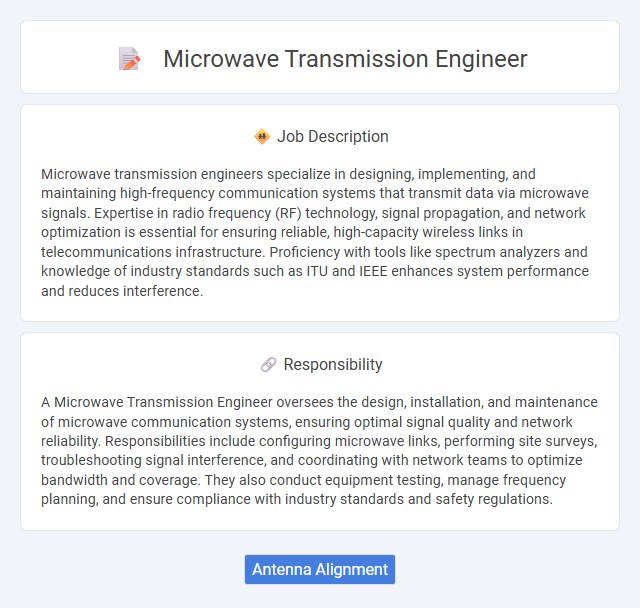
Microwave transmission engineers specialize in designing, implementing, and maintaining high-frequency communication systems that transmit data via microwave signals. Expertise in radio frequency (RF) technology, signal propagation, and network optimization is essential for ensuring reliable, high-capacity wireless links in telecommunications infrastructure. Proficiency with tools like spectrum analyzers and knowledge of industry standards such as ITU and IEEE enhances system performance and reduces interference.
Microwave transmission engineer roles likely suit individuals who are detail-oriented and comfortable working with complex technical systems in outdoor or remote environments. Candidates with strong problem-solving skills and a tolerance for occasional physical challenges may have a higher probability of success in this field. Those who prefer stable, indoor work settings might find this job less compatible with their preferences.
Qualification
A Microwave Transmission Engineer requires a strong background in electrical engineering, telecommunications, or a related field, often holding a bachelor's degree as a minimum qualification. Expertise in RF principles, microwave link design, and network optimization is essential, along with proficiency in using transmission testing equipment and software tools like spectrum analyzers and network simulators. Certifications such as CCNA Wireless or relevant vendor-specific credentials enhance employability and demonstrate advanced knowledge in microwave communication systems.
Responsibility
A Microwave Transmission Engineer oversees the design, installation, and maintenance of microwave communication systems, ensuring optimal signal quality and network reliability. Responsibilities include configuring microwave links, performing site surveys, troubleshooting signal interference, and coordinating with network teams to optimize bandwidth and coverage. They also conduct equipment testing, manage frequency planning, and ensure compliance with industry standards and safety regulations.
Benefit
Microwave transmission engineers likely benefit from high demand in telecommunications and broadcast industries, leading to promising job stability and growth. The role probably offers opportunities to work with advanced technologies, enhancing both technical skills and career development. Competitive salaries and potential for project-based bonuses may further contribute to the overall attractiveness of this profession.
Challenge
Microwave transmission engineers likely face challenges related to maintaining signal integrity over long distances, which can be affected by environmental factors such as weather and physical obstructions. Troubleshooting complex interference issues and optimizing network performance are probable daily tasks requiring advanced technical skills. Rapid technological advancements may also demand continuous learning and adaptation to new equipment and protocols.
Career Advancement
Microwave transmission engineers specialize in designing, maintaining, and optimizing high-frequency communication systems critical for telecommunications and data networks. Career advancement opportunities include roles such as senior engineer, project manager, or technical consultant, often requiring expertise in emerging technologies like 5G, mmWave, and fiber-wireless integration. Continuous skill development in network protocols, signal processing, and regulatory compliance enhances prospects for leadership positions and specialized engineering roles within telecommunications firms.
Key Terms
Antenna Alignment
Microwave transmission engineers specializing in antenna alignment ensure precise positioning and calibration of microwave antennas to optimize signal strength and minimize interference across communication networks. They utilize advanced tools like spectrum analyzers and GPS systems to achieve accurate alignment, essential for maximizing link reliability and data throughput. Expertise in antenna gain patterns, propagation characteristics, and environmental impact analysis is critical for maintaining high-performance microwave transmission systems.
 kuljobs.com
kuljobs.com